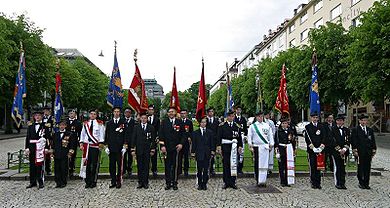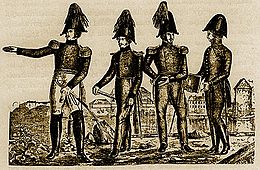
Buekorps
Encyclopedia

The tradition, which is unique to Bergen
Bergen
Bergen is the second largest city in Norway with a population of as of , . Bergen is the administrative centre of Hordaland county. Greater Bergen or Bergen Metropolitan Area as defined by Statistics Norway, has a population of as of , ....
, dates back at least to the 19th century when children would imitate the adult militia soldiers performing close order drill
Parade (military)
A military parade is a formation of soldiers whose movement is restricted by close-order manouevering known as drilling or marching. The American usage is "formation or military review". The military parade is now mostly ceremonial, though soldiers from time immemorial up until the late 19th...
. The organizations, which are called "bataljoner" ("battalions"), were first formally organized in the 1850s and are run entirely by the youths themselves. 14 different such "battalions" are active in Bergen, each usually belonging to a certain part of town.
In the past brigades were also formed in other Norwegian cities. But probably from the lacking city- and neighbourhood-patriotism, these were mostly defunct by the early 20th century.
Though the structure and ceremony of the Buekorps has military roots, the brigades are active in various other ways, ranging from physical activity and play to charitable work. Members range in age from about 7 to over 20, and adult veterans play a role in supporting the organizations and during certain events.

Drummer
A drummer is a musician who is capable of playing drums, which includes but is not limited to a drum kit and accessory based hardware which includes an assortment of pedals and standing support mechanisms, marching percussion and/or any musical instrument that is struck within the context of a...
s. The buekorps have their official season from March through the summer, but are most active during spring, with Norwegian Constitution Day
Norwegian Constitution Day
Norwegian Constitution Day is the National Day of Norway and is an official national holiday observed on May 17 each year. Among Norwegians, the day is referred to simply as syttende mai or syttande mai , Nasjonaldagen or Grunnlovsdagen , although the latter is less frequent.- Historical...
on May 17th as the high point of the season. On that day they are a prominent and popular part of the parade through the streets of Bergen.
In addition, the buekorps have their own celebratory days. One of these is the day they celebrate the founding date of their battalion. Every fourth year is Buekorpsenes Dag (The Buekorps Day), a series of competitions and pageantry.
Traditionally an activity exclusively for boys, the first girl buekorps was formed in 1991. This stirred some controversy in Bergen, but the girl and mixed gender battalions are now accepted by most people.
The buekorps tradition, even with many battalions experiencing trouble in keeping up the recruiting of new soldiers, continues to be a popular and proud feature of Bergen, excepting the odd complaint about noise.
Background

Ludvig Holberg
Ludvig Holberg, Baron of Holberg was a writer, essayist, philosopher, historian and playwright born in Bergen, Norway, during the time of the Dano-Norwegian double monarchy, who spent most of his adult life in Denmark. He was influenced by Humanism, the Enlightenment and the Baroque...
it is told of boys playing and marching on the streets of Bergen
Bergen
Bergen is the second largest city in Norway with a population of as of , . Bergen is the administrative centre of Hordaland county. Greater Bergen or Bergen Metropolitan Area as defined by Statistics Norway, has a population of as of , ....
. The city militia
Militia
The term militia is commonly used today to refer to a military force composed of ordinary citizens to provide defense, emergency law enforcement, or paramilitary service, in times of emergency without being paid a regular salary or committed to a fixed term of service. It is a polyseme with...
fascinated boys in the 18th and 19th century. They would build their own "fortresses" where they would play and engage in "warfare" against other boy-gang
Gang
A gang is a group of people who, through the organization, formation, and establishment of an assemblage, share a common identity. In current usage it typically denotes a criminal organization or else a criminal affiliation. In early usage, the word gang referred to a group of workmen...
s. Consul August Konow tells from his lifetime that at the end of the 18th century there existed boy-gangs and companies who marched around and engaded in "warfare" with each other. These gangs were called "Nordnæs Kompani" and "Nykirkealmeningens Kompani" and were direct copies of the town militia.
Governor Fredrik Hauch also tells from the same time about boy-gangs who were copying the town milita. Names like "fjeldeguttene" ("the Fjeldet-boys"), "markeguttene" ("the Marken-boys") and "dræggaguttene" ("the Dræggen-boys") were known at the end of the 18th century.
Johan Sebastian Welhaven
Johan Sebastian Welhaven
Johan Sebastian Cammermeyer Welhaven was a Norwegian author, poet, critic and art theorist.-Background:...
with his poem "børnelege" ("child doctor") from 1839 gives a picture of his childhood-years in 1814:
"Vi stilledes os siden i lange Rader, marsjerende tappert i byens gader ;vi plyndrede Søstrenes Dukkeskrin og gjorde Mundurer av silke og lin. I krigsraadet taltes med megen vekt om fienden stilling og skjulte planer, paa chefens kommando, vi stormede kjækt med skillingstrompeter, karduspapirfaner".
("We organized ourselves in long rows, marched bravely the streets of the city; we plundered our sisters doll-boxes and made coats out of silk
Silk
Silk is a natural protein fiber, some forms of which can be woven into textiles. The best-known type of silk is obtained from the cocoons of the larvae of the mulberry silkworm Bombyx mori reared in captivity...
and linen
Linen
Linen is a textile made from the fibers of the flax plant, Linum usitatissimum. Linen is labor-intensive to manufacture, but when it is made into garments, it is valued for its exceptional coolness and freshness in hot weather....
. In the council of war we gravely discussed the enemy's position and secret plans, and on the command of the chief we charged with shilling trumpets and paper banners".)
Nils Hertzberg says of the 1830s: There were organized boy-gangs in the different neighbourhoods which under changing alliances delivered each other full-blown battle
Battle
Generally, a battle is a conceptual component in the hierarchy of combat in warfare between two or more armed forces, or combatants. In a battle, each combatant will seek to defeat the others, with defeat determined by the conditions of a military campaign...
s: The Nordnæs-, Drægge-, Nøste- and Skive-Boys. They employed guards and scouts who made strategic moves to surprise the enemy.
In the 1850s these boy-gangs still rampaged, but the violent and hostile line had to come to an end. Who it was that finally ended these hostilities and turned into more like the current peaceful boy-organizations of buekorps is uncertain.
Lørdagskorps and Søndagskorps
Lørdagskorps ("Saturday-brigades") and Søndagskorps ("Sunday-brigades") is historically the two main types of buekorps. These terms originates from which day the brigades marched on.Saturday-brigades were composed of the sons of those who could afford to take a day off on Saturday to march. The three surviving Saturday-brigades are Nordnæs Bataillon, Nygaards Bataljon and Dræggens Buekorps.
Sunday-brigades were the ones from working-class neighbourhoods where the children had to work on Saturdays, and thus couldn't march on any other day. Most of the brigades were Sunday-brigades. Some of these brigades came from such poor families that they couldn't afford real uniforms. They did therefore instead wear ornated shirts. Today, Laksevågs Bueskyttere and Løvstakkens Jægerkorps still marches in these shirts.
The current brigades
- Dræggens Buekorps (24 March 1856), – Dræggens Archery Company, boys brigade http://www.dreggens.no/
- Eidsvaags Kompani (28 April 2008) "Eidsvaags Værve Kompani", Boys brigade.
- Fjeldets Bataljon (22 May 1857), Fjeldets Battalion, boys brigade http://www.fjeldetsbataljon.com/
- Laksevågs Bueskyttere (8 May 1894), Laksevåg's Archerers, boys brigade http://www.laksevaagsbueskyttere.no/
- Lungegaardens Buekorps (7 October 1994), Lungegaarden's Archery Company, girls brigade http://www.lungegaardens.com/
- Løvstakkens JægerkorpsLøvstakkens JægerkorpsLøvstakkens Jægerkorps is a buekorps in Bergen. It is mainly the buekorps for the neighbourhood of Løvstakksiden. It was founded for the first time in 1903, then for boys only. On May 11, 1999 it was founded again as a "mixed brigade", allowing both boys and girls as members...
(11 May 1903-18, 30 April 1928-64, 11 May 1999-), Løvstakken's Jeger Company, mixed brigade http://www.lovstakkensjaegerkorps.com/ - Markens Bataljon (4 June 1859), Marken's Battalion, boys brigade http://www.markens-bataljon.com/
- Mathismarkens Bataljon (15 June 1887), Mathismarken's Battalion, boys brigade
- Nordnæs BataillonNordnæs BataillonNordnæs Bataillon is a buekorps in Bergen that was established 3 May 1858. The members primarily come from the eastern side of Nordnes....
(3 May 1858), Nordnæs' Battalion, boys brigade http://www.nordnes-bataillon.no/ - Nygaards Bataljon (14 June 1857), Nygaard's Battalion, boys brigade http://www.nygaards-bataljon.com/
- Sandvikens Bataljon (17 May 1857), Sandviken's Battalion, boys brigade http://www.sandvikensbataljon.no/
- Skansens BataljonSkansens BataljonSkansens Bataljon is a buekorps in Bergen that was established 22 June 1860. The buekorps has its headquarters in the old fire station at Skansen. Traditionally Skansen marcher on Sundays, but this was changed to Saturdays in 1951....
(22 May 1860), Skansen's Battalion, boys brigade http://www.skansensbataljon.com/ - Skutevikens Buekorps (8 July 1853), Skuteviken's Archery Company, boys brigade http://www.skutevikensbuekorps.com/
- Sydnæs Bataljon (7 June 1863), Sydnæs' Battalion, boys brigade http://www.sydnaesbataljon.com/
- Wesselengens Bataljon (24 April 1873), Wesselengen's Battalion, boys brigade http://www.wesselengen.no/

